Friday essay: the ‘great Australian silence’ 50 years on
Australian Research Council Future Fellow in Public History, University of Technology Sydney
It’s 50 years since the anthropologist WEH Stanner gave the 1968 Boyer Lectures — a watershed moment for Australian history. Stanner argued that Australia’s sense of its past, its very collective memory, had been built on a state of forgetting, which couldn’t “be explained by absent mindedness”:
It is a structural matter, a view from a window which has been carefully placed to exclude a whole quadrant of the landscape. What may well have begun as a simple forgetting of other possible views turned under habit and over time into something like a cult of forgetfulness practised on a national scale.
His lectures profoundly influenced historians partly because of the image he captured: for a practice based on documentation, archiving and storytelling, silence is a compelling idea. And a whole-scale silence — a “cult of forgetfulness”, no less —indicated a bold re-imagining of a national historiography on Stanner’s part.
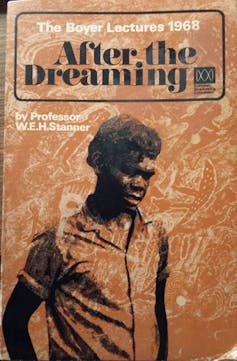
As Stanner insisted, this sort of silence was no “absent-mindedness”: the occlusion of Aboriginal people from Australian history wasn’t inevitable.
In the wake of his lectures, influential Australian historians conceived of their own historical awakening in these same terms. In an autobiographical essay historian Marilyn Lake described the prevailing historical view in her small rural town: “Growing up in the former colony of Tasmania we did our fair share of forgetting”. And in his evocative memoir, Why Weren’t We Told? Henry Reynolds famously pondered that shift away from silence as people endeavoured to write in Indigenous perspectives from the 1970s onwards.
It’s a common refrain. I remember my dad describing how he also “hadn’t been told” about Australia’s Aboriginal history when Reynolds’ book came out. And a colleague and friend recently recounted visiting Myall Creek as part of a Sunday school picnic in the 1980s: no-one mentioned its dark history as the site of an infamous Aboriginal massacre in 1838.
Yet the move from “great Australian silence” to historical “truth-telling” isn’t quite as clear cut as Stanner’s description might suggest. “Too often it is taken to imply a kind of historiographical periodisation where there was no Aboriginal history before Stanner’s own lecture and an end to the silence after it”, writes Ann Curthoys. Yet that doesn’t capture the whole picture: “there was neither complete silence before 1968, nor was it completely ended afterwards”.
While we now have important interventions into Aboriginal history that amplify Australia’s uncomfortable past, such as Lyndall Ryan’s massacre map and the Uluru Statement from the Heart, those reverberations continue to cause anxiety.
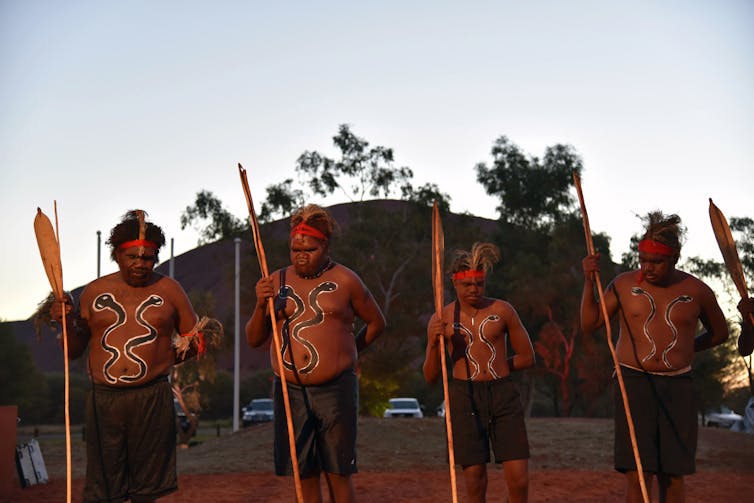
The Statement from the Heart called for a “truth-telling about our history” but still awaits bipartisan support; meanwhile, online commentary in response to the release of Ryan’s massacre database shows the persistence of historical refusal in Australia.
‘Black crows’
The “great Australian silence” is also historically a little more complex. I’m writing a history of history-making in Australia and have been struck by the detailed interest in Aboriginal life as well as the often graphic accounts of frontier violence in works from the early and mid-19th century. For want of colonial history “texts”, I’ve also been reading travelogues and emigrant’s guides. While these books and pamphlets are largely observational, they also frequently present historical narratives and interpretation.
Many of them didn’t hold back in their tales from the colonial frontier, cataloguing extensive episodes of violent conflict between Aboriginal people and colonialists.
Have a look at this description of the 1838 Myall Creek massacre from Godfrey Charles Mundy in his travelogue, Our Australian Antipodes, published in 1852:
[The perpetrators,] with the exception of a child or two; and having bound them together with thongs, fired into the mass until the entire tribe, 27 in number, were killed or mortally wounded. The white savages then chopped in pieces their victims, and threw them, some yet living, on a large fire; a detachment of the stockmen remaining for several days on the spot to complete the destruction of the bodies.
It is graphic historical writing.
The horror of Mundy’s Myall Creek account is paradoxically eclipsed by the chilling official silence he observes after most attacks:
Reprisals [against Aboriginal people] are undertaken on a large scale – a scale that either never reaches the ears of the Government, which is bound to protect alike the white and the black subject; or, if it reaches them at all, finds them conveniently deaf.
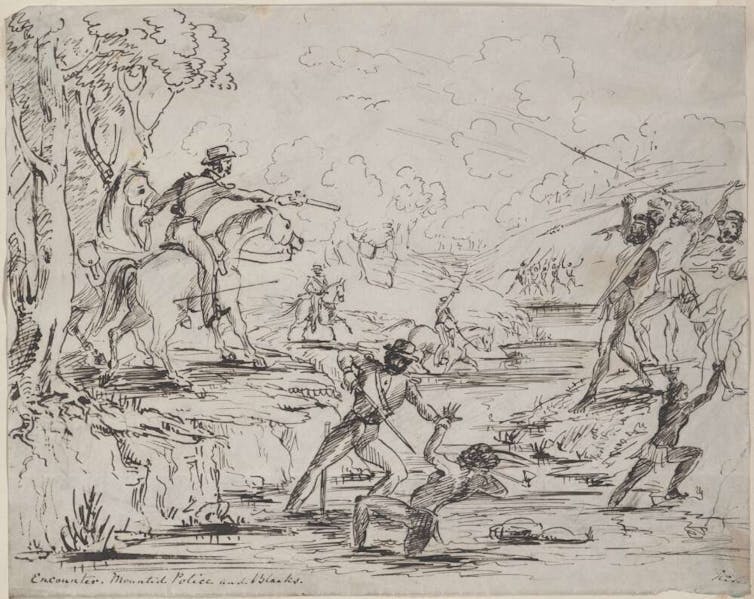
James Demark’s Adventures in Australia Fifty Years Ago, from 1893, similarly reports a structural and deliberate deafness in response to the violent, eerie echoes across the frontier: “The settlers retaliated in their own way”, he writes, and “there were no Government regulations to check these irregular proceedings”.
Even self-described histories, such as those by James Bonwick and John West, explicitly link frontier violence with Australia’s colonisation. West’s History of Tasmania, first published in 1852, even uses the terms “black hunts” and “black war” to describe the first 50 years of Van Diemen’s Land. West was an abolitionist, and a tone of historical injustice inflects his writing about the Tasmanian Aborigines in volume two.
Take this excerpt, where he relates the perverse logic of colonial expansion:
It was better that the blacks should die, than that they should stain the settler’s heath with the blood of his children.
And this one, where he mourns the destruction of Tasmanian Aboriginal society in only two generations:
At length the secret comes out: the tribe which welcomed the first settler with shouts and dancing, or at worst looked on with indifference, has ceased to live.
Bonwick’s 1870 history of Tasmania is similarly full of sentiment. In a tone curiously analogous to Paul Keating’s Redfern Park speech 120 years later, Bonwick offers this lament on the effects of colonisation on Tasmania’s Aboriginal people:
We came upon them as evil genii, and blasted them with the breath of our presence. We broke up their home circles. We arrested their laughing corrobory. We turned their song into weeping, and their mirth to sadness.
Bonwick also reveals the ease with which colonial discourse accounted for murder. During his time in Tasmania, Bonwick writes, he had heard several people explain that “they thought no more of shooting a Black than bringing down a bird”. He went on: “Indeed, in those distant times, it was common enough to hear men talk of the number of black crows they had destroyed”.
Those recollections of euphemistic colonial vernacular hint at some of Bonwick’s method as a historian. In the introduction to his history and in an 1895 talk to the Royal Colonial Institute in London, he gives a more detailed explanation of that approach.
It was not a hunt through blue books [government records], that provided the source material for his research, he explains. Rather, it was conversation and hearsay, from sly-grog sellers, ex-bushrangers and colonial gentry alike, that furnish his historical narrative.
How else could you write about hunting crows?
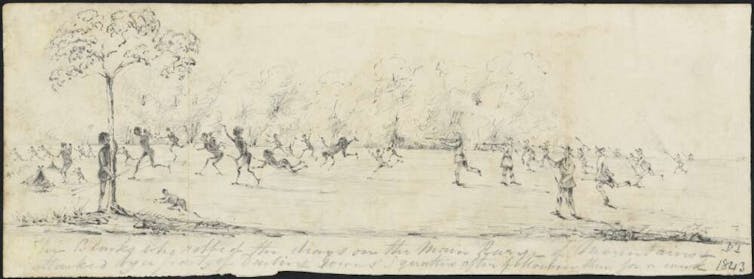
Alongside those histories was a humanitarian public discourse that anguished over frontier violence. Media commentary, public debates and lectures, as well as letters to the editor from the frontier that related specific episodes of violence, are explored in detail by Henry Reynolds in This Whispering in Our Hearts.
Likewise, poetry such as The Aboriginal Mother (1838) by Eliza Hamilton Dunlop reveals a form of popular and creative history-making in response to colonisation that can be seen in the work of writers such as Judith Wright and Eleanor Dark a century later.
So why was that reverberation replaced with euphemism and omission? Partly the silence was a fear of punishment, as Bain Attwood argues in a recent essay on historical denial.
Especially after the successful prosecution of the Myall Creek massacre perpetrators, colonial frontlines and allegiances became a little murkier. “There were good reasons to be silent,” historian Tom Griffiths has similarly insisted.
Mundy’s 1852 account of his “ramble” through the antipodes confirms Attwood and Griffiths’ explanation, and reveals how stories quietly murmured along the frontier provided a catalogue of violence.
“Dreadful tales of cold-blooded carnage have found their way into print, or are whispered about in the provinces,” he writes. And
although there be Crown land commissioners, police magistrates, and settlers of mark, who deny, qualify, or ignore these wholesale massacres of the black population, there can be no real doubt their extirpation from the land is rapidly going on.
‘Historia nullius’
It wasn’t simply a case of an uncomfortable frontier that came to characterise the silence Stanner identified in his Boyer lectures, however.
The historians Stanner named in his lectures (such as M. Barnard Eldershaw, Hartley Grattan, Max Crawford and Brian Fitzpatrick) were largely silent on Aboriginal policy and history in their mid-20th century histories — despite being written after the 1930s, a decade which Stanner notes for its influence in shapeshifting on Aboriginal policy.
Yet this form of history writing had begun in the late 19th century. At a time when Australian nationhood and national identity were being formed around Federation, the historical discipline was moving into a particular form of narrative writing oriented towards (non-Indigenous) Australian exceptionalism based on democratic and economic progress.
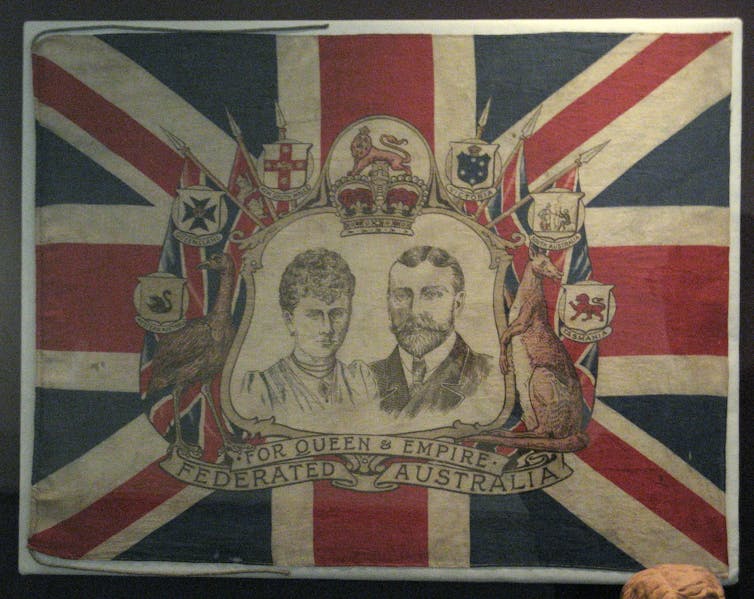
As Australia’s national consciousness emerged, it required a historical consciousness of its own origin. Education departments commissioned history texts and universities appointed history professors. As history became increasingly professionalised “blue books” and official archives were in; hearsay and poetry out.
So what did disciplinary “silence” look like in Australia? It saw History (with a capital “H”) arriving with colonisation: “She alone of all the continents has no history”, proclaimed journalist Flora Shaw in a presentation about Australia to the Royal Colonial Institute in London in 1894.
She offers the introductory chapter of a new history and bases her claim to the attention of the world upon the future which she is shaping for herself.
Lorenzo Veracini has described that settler-colonial vision of the Australian continent as a sort of historia nullius, where “Australian history” only existed thanks to the selective creation and curation by colonial historians.
For Australian historians in the late 19th and early 20th centuries, the silence of pre-and post-contact Indigenous experience occurred because it existed outside the Whiggish historical narrative of imperial progress. “The federation of (white) Australia and the birth of ‘national’ historical consciousness thus represent … a moment of disciplinary origin”, historian Leigh Boucher asserts.
In his 1916 Short History of Australia, Ernest Scott described “vast tracts of fertile country which had never rung under the hoof of a horse and where the bleat of a sheep had never been heard.” In these texts, silence is counterposed against the ringing of axes and “industry”.
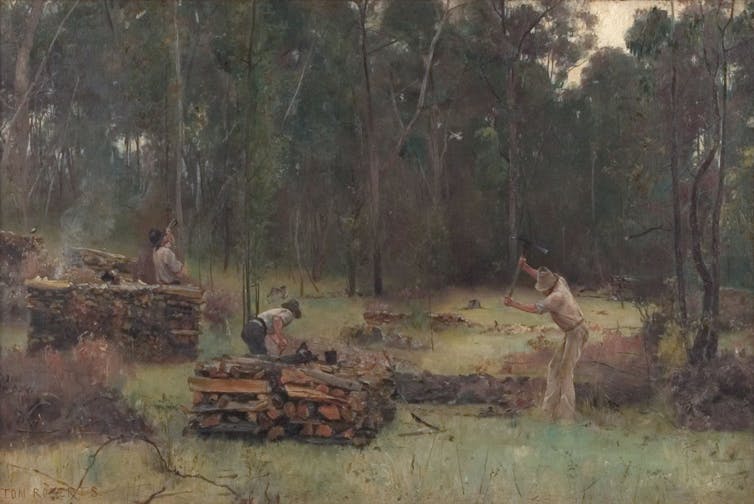
Scott writes that Australia “begins with a blank space of the map, and ends with the record of a new name on the map, that of Anzac”. It’s worth dissecting this quote here, to unpack that form of history writing: the inevitability of historical progress and national formation is telling.
We shouldn’t assume that this early national history writing was completely silent on Indigenous matters: Coghlan and Ewing’s 1902 Progress of Australasia in the Nineteenth Century described the “invasion” of parts of southern Australia by the colonists, and related in some detail the colonial massacre of Aboriginal people at Risden Cove in Tasmania; and Scott’s 1916 short history included ghastly and violent accounts of murder on the colonial frontier, as well as the deliberate planting of arsenic in flour destined for Aboriginal people.
Nevertheless, Stanner gave voice to an emergent idea about silence that understands history as a method that changes over time and place, rather than an objective interpretation of the past. It reminds me of what narrative psychologist Jerome Bruner explains as the “coherence” we “impose” on the past, to “make it into history”.
In other words, the 1930s histories that Stanner identified in his Boyer lectures exist in a historical structure where Indigenous perspectives have been locked out. As Stanner himself articulated,
We have been able for so long to disremember the Aborigines that we are now hard put to keep them in mind even when we most want to do so.
Still a work-in-progress
Stanner’s point raises an important question: if “History” itself is tied to the process of colonisation, can it accommodate perspectives outside its colonial apparatus? Stanner sensed that history would overcome its own silences, but doing so would require major methodological shifts, such as the incorporation of Aboriginal Studies and oral history:
In Aboriginal Australia there is an oral history which is providing these people with a coherent principal of explanation … It has a directness and a candour which cut like a knife through most of what we say and write.
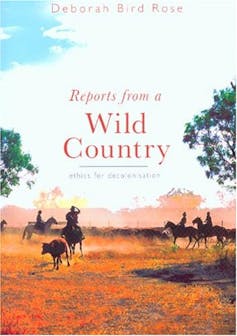
His predictions played out, and such approaches, applied by Indigenous and non-Indigenous historians such as Hobbles Danyari, Heather Goodall, Peter Read, Paddy Roe and Deborah Bird Rose overturned Aboriginal historiography in Australia.
The murmurings have since turned into a groundswell: Indigenous histories have become increasingly prominent and Indigenous perspectives are now mandated across school curricula. Conspicuous public and political debates over Australian history are further indication of how this counter narrative has become a significant historical lens.
“I hardly think that what I have called ‘the great Australian silence’ will survive the research that is now in course”, Stanner anticipated. And to a large degree, he was right — a substantial historical revision has taken place in Australia.
If anything, that change has accelerated since Stanner’s death in 1981. Yet in university history departments, Indigenous historians still remain vastly underrepresented.
Indigenous perspectives have increasingly informed, critiqued and revised historical approaches. But Indigenous histories are often relegated to “memoir”, “story”, “family history”, “narratives of place” or “political protest”, rather than acknowledged as part of a disciplinary practice.
And with the possible exception of oral history and pre-history/deep time, there is still a marked absence of Indigenous historiography in Australia’s historical “canon”.
We may have developed new critical approaches, and a growing understanding of the genealogy of historical “silence”. Yet the meaning and the consequences of that understanding are still a work in progress.
https://theconversation.com/friday-essay-the-great-australian-silence-50-years-on-100737

0 Comments:
Post a Comment
Subscribe to Post Comments [Atom]
<< Home